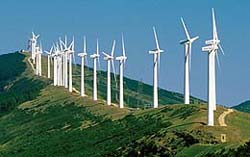Australian Windpower goes global

© Copyright CSIRO Australia, 14.07.2003
Australian windpower technology is reaching out to a global market, as science, technology and industry come together in a new wind energy consulting company based in Canberra.
Former CSIRO scientists, Dr Keith Ayotte and Dr Nathan Steggel developed what is seen to be world’s best available wind resource technology, WindScape and Raptor NL.
Windscape is believed to be the leading wind mapping tool and enables power prospectors to find the windiest spots down to property boundaries. RaptorNL identifies how air accelerates and decelerates over complex land features and vegetation. RaptorNL demonstrates significant improvements over current industry standard models.
“WindLab Systems Pty Ltd uses leading edge science combined with practical industry experience to offer global wind energy stakeholders intelligence on wind resources,” says the new company’s Chief Executive, Gareth Johnston.
Mr Johnston says that 87% of global windpower capacity is currently developed in Europe, but there is strong interest in the Australian-designed systems.
Windpower is one of the fastest-growing and cost effective ways of producing green energy in the world.
“Given the scale of development in Europe, developers, energy companies, project financiers and governments need to better understand where the wind resource is,” says Mr Johnston.
“Our technology helps developers to reduce development time, optimise resource and increase yield.”
Services provided by WindLab can reduce cumulative impact caused by multiple developers competing for known coastal wind sites. WindLab have mapped and identified over seventy regions including most of Australia, says Mr Johnston.
“Locally, we have identified a large number of development sites with great wind resource in South Australia, Victoria and New South Wales that are located away from sensitive coastal regions,” says Mr Johnston. “These sites could be developed faster with reduced visual impacts. Two state governments are using our wind mapping services to develop strategic planning.
” We have signed an MOU with a strategic partner to provide turnkey development services in Asia and are very excited about the wind energy potential of India and China,” he says.
CSIRO Chief Executive Dr Geoff Garrett says that WindLab is a great example of Australian science joining forces with Australian industry.
“WindLab Systems capitalises on seven years of leading-edge research at CSIRO Land and Water,” says Dr Garrett. “Our world class science combined with WindLab’s industry experience makes an unbeatable combination. We can expect WindLab to be doing business with groups from farmers and community groups through to major international energy companies.
“We congratulate the new company and wish them fair winds and a prosperous voyage!”
WindLab’s founders and principal equity holders are the CSIRO and business incubator Epicorp, which is funded by the Australian Government through its Building on IT Strengths Incubator Program.
“This demonstrates the Australian Government’s commitment to making this country’s ICT sector among the best in the world,” says Senator Alston, Minister for Communications, Information Technology and the Arts.
More information, footage, from:
Gareth Johnston, WindLab, 0433 108 391
Jan Bingley, CSIRO, 02-9490 8262
Media Contact
More Information:
http://www.csiro.au/index.asp?type=mediaRelease&id=PrwinlabAll latest news from the category: Power and Electrical Engineering
This topic covers issues related to energy generation, conversion, transportation and consumption and how the industry is addressing the challenge of energy efficiency in general.
innovations-report provides in-depth and informative reports and articles on subjects ranging from wind energy, fuel cell technology, solar energy, geothermal energy, petroleum, gas, nuclear engineering, alternative energy and energy efficiency to fusion, hydrogen and superconductor technologies.
Newest articles

High-energy-density aqueous battery based on halogen multi-electron transfer
Traditional non-aqueous lithium-ion batteries have a high energy density, but their safety is compromised due to the flammable organic electrolytes they utilize. Aqueous batteries use water as the solvent for…

First-ever combined heart pump and pig kidney transplant
…gives new hope to patient with terminal illness. Surgeons at NYU Langone Health performed the first-ever combined mechanical heart pump and gene-edited pig kidney transplant surgery in a 54-year-old woman…

Biophysics: Testing how well biomarkers work
LMU researchers have developed a method to determine how reliably target proteins can be labeled using super-resolution fluorescence microscopy. Modern microscopy techniques make it possible to examine the inner workings…





















